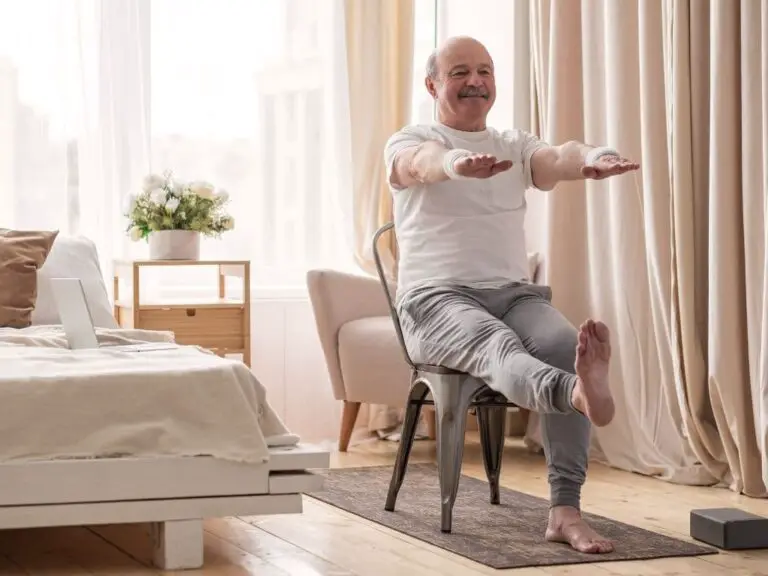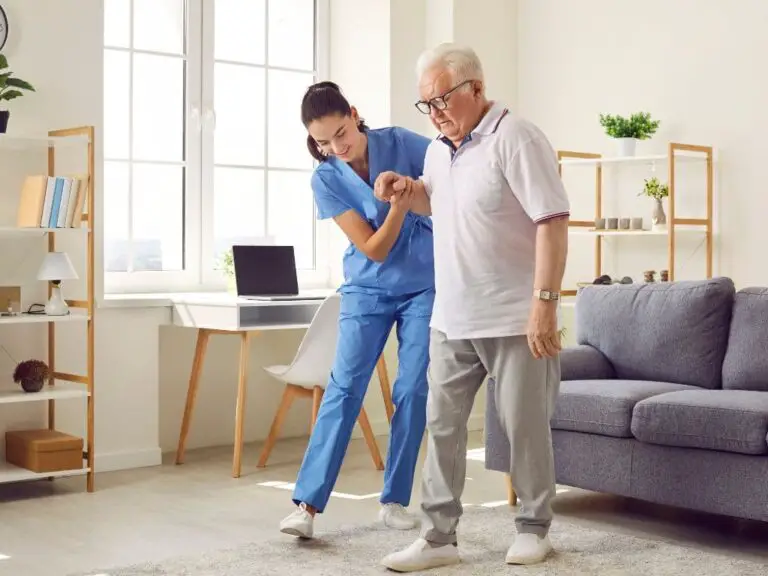Why Do Elderly Legs Give Out?
As we age, it’s common to experience some degree of leg weakness or instability. This can lead to difficulty standing, walking, and an increased risk of falls in the elderly.
Elderly legs often “give out” due to a combination of natural aging processes and lifestyle factors. Age-related changes include loss of muscle mass, reduction in bone density, decline in nervous system function, and impaired blood circulation. Lifestyle factors such as inactivity, poor diet, and certain medications can exacerbate these issues. These factors contribute to leg weakness, instability, and an increased risk of falls in the elderly.
There are many potential causes that can contribute to elderly legs “giving out.” Understanding the relationship between aging and leg weakness can help older adults maintain strength, mobility, and independence.

What is the Relationship Between Aging and Leg Weakness?
Aging brings natural changes to the muscles, bones, nerves, blood vessels and joints in the legs that can lead to loss of strength. Muscle mass tends to decrease with age, a condition known as sarcopenia. This causes muscles to become smaller and weaker over time. The number and size of muscle fibers also decrease. These age-related changes reduce strength and endurance.
Bones also become weaker with age as density decreases. This can lead to osteoporosis, making bones more susceptible to fractures. Arthritis causes deterioration in the joints, resulting in stiff, painful knees and hips that limit mobility. Balance and coordination depend on receptors in the feet, ankles and legs that can become less responsive with aging. All of these factors contribute to general leg weakness.
How Does Inactivity Contribute to Leg Weakness in the Elderly?
An inactive lifestyle can accelerate the loss of leg strength that comes naturally with age. The common tendency to become more sedentary as we get older results in reduced muscle mass and strength in the legs. Prolonged periods of inactivity, such as long bed rest, can be especially detrimental.
Without regular exercise, leg muscles weaken and atrophy. Weight-bearing activities that load and strengthen bones become less frequent. Stiff joints lose range of motion. Impaired circulation and nerve function can also develop from disuse. This combination of changes significantly contributes to overall leg weakness and instability.
What Role Do Muscles and Bones Play in Elderly Leg Weakness?
Muscles and bones both play central roles in maintaining leg strength and mobility as we age. The muscles that straighten the knees and hips, like the quadriceps and glutes, are particularly important for standing, walking and balance. Age-related loss of muscle cells causes these muscles to atrophy and weaken. Sarcopenia reduces muscle strength by 3% per year after age 60.
Osteoporosis is a common age-related bone disease in which decreased bone mineral density causes bones to become fragile and prone to fracture. This affects the bones of the hip, spine and wrist most often. Osteoporosis in the hips and legs contributes to disability and difficulty walking. Fractures require long healing times that can severely reduce mobility.
How Does the Nervous System Affect Elderly Leg Strength?
The nervous system plays a crucial role in controlling leg muscles for standing and walking. Several factors influence the nervous system’s ability to properly activate muscles as we age:
- Decline in the number of nerve cells
- Reduced nerve transmission speed
- Decreased reflexes
- Impaired balance and proprioception
These nervous system changes disrupt coordination between muscles, making the legs feel unstable and unsteady. Reflexes that trigger muscles to contract rapidly to catch oneself from falling become slower. Balance becomes poor when position sense from the feet declines. All of these nerve-related factors lead to leg weakness.
How Can Blood Vessels and Heart Health Impact Leg Strength in the Elderly?
Atherosclerosis, a buildup of plaque in arteries, can restrict blood flow in the elderly. This commonly affects blood vessels leading to the heart, brain and legs. When blood circulation to the legs is impaired, it deprives muscles of oxygen and nutrients needed for optimal function.
If the heart is unable to pump sufficiently due to cardiovascular disease, leg muscles may fatigue more quickly due to inadequate blood flow. Weakened heart muscle or abnormal heart rhythms reduce cardiac output. Overall diminished circulation can contribute significantly to limiting exercise capacity and leg strength.
What is the Connection Between Diabetes, Atherosclerosis, and Leg Weakness in the Elderly?
Diabetes accelerates the atherosclerosis process, increasing risk of peripheral arterial disease. When arteries become narrowed, blood flow to the legs is greatly reduced. This commonly causes calf pain with activity, known as claudication. Severe lack of circulation can lead to foot ulcers and infections.
Nerve damage (peripheral neuropathy) is another complication of diabetes that can cause leg weakness. High blood sugar injures nerves in the legs and feet, leading to pain, numbness, and muscle weakness. Uncontrolled diabetes hastens loss of leg strength due to both vascular and nerve complications.
How Can Stroke, Spinal Cord Injury, and Pinched Nerves Lead to Leg Weakness in the Elderly?
Anything that disrupts the central nervous system pathways connecting the brain and spinal cord to the legs can result in leg weakness. A strokedamaging these nerve fibers or certain spinal cord regions leads to paralysis or weakness on one side of the body.
Injury to the spinal cord from trauma, ruptured discs, or pinched nerves in the back interferes with neural signals to the leg muscles. This causes abrupt leg weakness, stumbling, and loss of coordination depending on the spinal location affected. Regaining leg strength requires rehab and sometimes surgery.
What are the Signs of Peripheral Neuropathy in the Elderly?
Peripheral neuropathy, nerve damage most often from diabetes, produces several signs in the legs:
- Numbness or decreased sensation in the feet
- Tingling, burning, or shooting nerve pain
- Loss of reflexes at the ankle
- Muscle weakness, cramps, and twitching
- Difficulty moving the ankle and toes
- Lack of coordination and balance
These symptoms indicate peripheral nerves are dysfunctional and failing to stimulate leg muscles properly. This causes instability when walking and contributes to risk of falls. Managing diabetes can help slow neuropathy progression.
How Can Osteoporosis and Degenerative Joint Disease Cause Leg Weakness?
With osteoporosis, the hip and spine become prone to fractures that severely limit mobility. Hip fractures almost always require surgery, after which most elderly patients do not regain their former level of function. Pain, stiffness, and joint deformity from arthritis also reduce leg strength.
Knee arthritis from degenerative joint disease makes it painful to walk, climb stairs, or stand from a sitting position, which are all important for leg muscle use. Arthritis gradually worsens until joint replacement surgery is required. Both osteoporosis and arthritis inhibit the ability to fully use the leg muscles and cause weakness.
What are the Symptoms of Arthritis-Related Leg Weakness in the Elderly?
The most common symptoms of arthritis involving the legs include:
- Aching pain and stiffness in the knees, hips, or ankles, worse with activity
- Joint swelling, tenderness, and loss of range of motion
- Grating or cracking sensation with joint movement
- Knee buckling or giving way
- Difficulty standing from sitting
- Impaired balance and increased risk of falling
- Weakness climbing stairs or getting out of vehicles
Arthritis-related leg weakness limits function and mobility. Using a cane or walker provides stability and takes pressure off sore joints. Losing weight also helps reduce joint discomfort.
How Do Parkinson’s Disease and Multiple Sclerosis Contribute to Leg Weakness?
Parkinson’s disease affects nerve cells in the brain that control muscle movement. This results in tremors, rigid muscles, impaired balance, and shuffling steps. Leg muscles become stiff and difficult to initiate movements like getting up from a chair. Steps become shorter and pace slows.
Multiple sclerosis damages the myelin coating around nerve fibers. This disrupts transmission of signals from the brain to the legs. Weakness, fatigue, numbness, and walking impairment are common multiple sclerosis symptoms. Leg weakness contributes greatly to loss of mobility in both conditions.
How Does Leg Weakness Increase the Risk of Falls in the Elderly?
Unsteady leg muscles lead to balance difficulties and accidents. The inability of weak leg muscles to react quickly and generate force to catch oneself is a major reason elderly falls are more likely to result in serious injury. Loss of position sense in the feet also increases falls.
Falls become more hazardous for those with osteoporosis, as bones are prone to fracture. Hip fractures often lead to permanent disability and loss of independence. Fear of falling frequently isolates the elderly and limits activity further worsening weakness. Leg strength is vital for fall prevention.
How Can Leg Weakness Lead to Disability in the Elderly?
Marked leg weakness interferes with performing routine daily tasks like bathing, dressing, housework, and grocery shopping. Climbing stairs to reach the bedroom or even standing up from a chair or toilet can become impossible without leg strength.
Mobility impairment from leg weakness leads many elderly to require walkers or wheelchairs. Loss of driving ability follows as pressing the gas and brake pedals becomes difficult. Significant leg weakness contributes tremendously to loss of independence and disability.
How Does Leg Weakness Affect Independence and Quality of Life in the Elderly?
Leg weakness diminishes an elderly person’s ability to remain self-sufficient and live independently. Relying on others for transportation, housekeeping, and personal care negatively impacts dignity and self-worth. Social isolation increases when mobility becomes limited.
Falls and decreased activity accelerate decline in the elderly. Depression often follows as mobility restrictions reduce engagement with life. Maintaining strength preserves independence that is so crucial to emotional well-being and quality of life. Physical therapy helps compensate but preventing weakness is ideal.
How Can Anemia and Vitamin Deficiency Contribute to Leg Weakness in the Elderly?
Anemia, meaning low red blood cells, deprives muscles of oxygen needed for energy. This causes fatigue, weakness, and shortness of breath. Anemia from iron or vitamin B12 deficiency is common in the elderly. Chronic diseases can also impair blood cell formation.
Low levels of vitamin D lead to muscle weakness since it is needed for muscle growth and function. D deficiencies are linked to reduced strength and physical performance in older adults. Addressing nutritional deficiencies and other causes of anemia provides energy for better leg strength.
What Role Do Medications Play in Causing or Treating Leg Weakness in the Elderly?
Some medications like diuretics, blood pressure pills, and cholesterol drugs deplete key minerals like potassium and magnesium required for muscle function. Blood pressure meds can also exacerbate circulation problems. Reviewing drug side effects with doctors is important.
On the other hand, some medications can improve age-related muscle weakness. Vitamin D supplements help those with deficiencies. Osteoporosis drugs strengthen fragile bones prone to fracture. Arthritis medication reduces joint inflammation that inhibits movement. Addressing drug effects helps optimize leg strength.
What Lifestyle Changes Can Help Prevent Leg Weakness in the Elderly?
While some muscle loss is inevitable with aging, many lifestyle factors play a role in maintaining leg strength:
- Regular strength training and weight-bearing exercise
- Stretching and balance activities like tai chi or yoga
- Eating adequate protein and nutrients like calcium and vitamin D
- Drinking enough fluids to avoid dehydration
- Taking vitamin supplements if deficient
- Quitting smoking to improve circulation
- Getting hearing and vision checked annually
Being proactive with a healthy lifestyle goes a long way towards preserving mobility and vitality.
How Can Balance and Mobility Exercises Improve Leg Strength in the Elderly?
Weight training targeting the major leg muscle groups is essential for maintaining strength. This should be done at least 2-3 times per week along with balance activities like standing on one foot. Tai chi helps coordination. Stretching maintains flexibility and joint mobility.
Low-impact aerobic exercise improves stamina and circulation in the legs. Walking daily, even just several minutes, preserves function better than prolonged sitting. Assessing risk of falling and assisting with gait/balance aids improves safety. Focusing exercise on leg strength preserves independence.
Frequently Asked Questions
-
Why do elderly legs give out?
PElderly legs “give out” due to age-related changes such as decreased muscle mass (sarcopenia), weaker bones (osteoporosis), joint deterioration (arthritis), and less responsive balance receptors. Inactivity accelerates these changes, while conditions like diabetes, cardiovascular disease, and central nervous system disorders can also contribute. These factors result in overall leg weakness, impaired mobility, and an increased risk of falls.
-
What is the best exercise for a 70 year old woman?
Aerobic exercise is important for seniors. They need to get at least 2 hours of exercise each week, such as brisk walking. This is about 30 minutes most days. Walking, dancing and tennis are endurance exercises that improve your energy, breathing and heart rate. Stretching and yoga are great ways to stay flexible.
-
What is the best exercise for weak legs?
Squats Squatting can be one of your most effective resistance exercises. The exercise strengthens your legs and works most of the lower body muscles. If you are looking to start resistance training, this is an essential part of your routine.
-
What is a good chair workout?
Your arms should be straight in front of your body, at about shoulder height. Keep your thumbs pointed toward the ceiling. Pull your shoulders back and extend your arms out in front of you. Return your arms to their original position. You can do this several times.
-
How effective are chair exercises?
Chair exercises can be done from the office, at home, or in class. They are low-impact and easy to add movement to your daily routine. A 32-minute session can help you burn between 120 and 250 calories. If you add weights or resistance bands, the number of calories burned will go up even further.
-
How often should seniors do chair exercises?
#1: Seniors can get a mood boost by doing chair exercises. All ages, even seniors, can enjoy physical and exercise. According to the Centers for Disease Control, seniors should exercise for 150 minutes each week.
-
Why might exercises while seated in a chair be more beneficial for older adults than ones that require them to sit on the floor?
You will be seated all the time so you have stability. This is not possible with activities that involve standing. The risk of injury from falls is significantly reduced by this method. Chair exercises can help you achieve greater flexibility and mobility.
-
Why do seniors have trouble getting up from floor?
It’s quite common for senior citizens to be unable to stand. This could be caused by injury, stiff joints or weak muscles. However, it is equally important to know what to do after falling.
-
What vitamin is good for weak legs?
You should eat foods rich in minerals such as magnesium, iron and potassium.
-
Can elderly regain leg strength?
Seniors can strength train up to 3 times per week. They should focus on each major muscle group during every session. Legs are vital when it comes to strength-training. Consistent weight training and stretching will result in an increase of muscle strength and flexibility.







